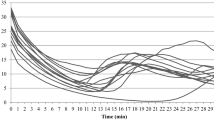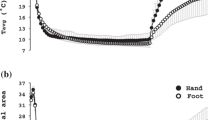Abstract
Purpose
The presumption in a cold sensitivity test (CST) used for cold injuries is that the skin temperature (T sk) observed reflects the return of blood flow to the extremity following a local cold challenge. We questioned this assumption.
Methods
Six non-cold injured participants undertook two CSTs in 30 °C air. The control (CON) CST involved 12 min gentle exercise prior to immersing the foot into 15 °C water for 2 min followed by 15 min of spontaneous rewarming. The occlusion (OCC) CST was the same except that blood flow to the foot was occluded during the rewarming period. These results were compared to CSTs from six individuals with non-freezing cold injury and moderate–severe cold sensitivity (CS) and a non-perfused human digit model (NPDM).
Results
Before immersion, great toe skin blood flow (SkBF) was similar in CON and OCC conditions [255 (107) laser Doppler units (LDU)] and was higher than CS [59 (52) LDU]. During rewarming, SkBF in CON returned to 104 % of the pre-immersion value and was higher than both OCC and CS. Great toe T sk before immersion was lower in CS [28.5 (2.1) °C] compared to CON [34.7 (0.4) °C], OCC [34.6 (0.9) °C] and NPDM [35.0 (0.4) °C]. During rewarming skin/surface temperature in OCC, CS and NPDM were similar and all lower than CON.
Conclusions
SkBF does contribute to the skin rewarming profile during a CST as a faster rate of rewarming was observed in CON compared to either OCC or NPDM. The lower T sk in CS may be due to a reduced basal SkBF.



Similar content being viewed by others
Abbreviations
- CON:
-
Control condition
- CS:
-
Cold sensitive group
- CST:
-
Cold sensitivity test
- LDU:
-
Laser Doppler units
- NFCI:
-
Non-freezing cold injury
- NPDM:
-
Non-perfused digit model
- OCC:
-
Occluded condition
- SkBF:
-
Skin blood flow
- T sk :
-
Skin temperature
References
Burgess JE, McFarlane F (2009) Retrospective analysis of the ethnic origins of male British army soldiers with peripheral cold weather injury. J R Army Med Corps 155:11–15
Charkoudian N, Johnson JM (1999) Reflex control of cutaneous vasoconstrictor system is reset by exogenous female reproductive hormones. J Appl Physiol 87:381–385
Clark S, Dunn G, Moore T, Jayson Mt, King TA, Herrick AL (2003) Comparison of thermography and laser Doppler imaging in the assessment of Raynaud’s phenomenon. Microvasc Res 66:73–76
Edwards CM, Marshall JM, Pugh M (1998) Lack of habituation of the pattern of cardiovascular response evoked by sound in subjects with primary Raynaud’s disease. Clin Sci 95:249–260
Eglin C (2011) Cold sensitivity in windsurfers. In: Kounalakis S, Koskolou M (eds) Proceedings of the 14th international conference on environmental ergonomics. National and Kapodestrian University of Athens, Greece, pp 47–48
Eglin C, Golden F, Tipton M (2005) Increasing the reproducibility of a cold sensitivity test for non-freezing cold injury. In: Holmer I, Kuklane K, Gao C (eds) Environmental ergonomics 2005. Lund University, Ystad, pp 274–277
Francis TJ (1984) Non-freezing cold injury: a historical review. J Roy Nav Med Serv 70:134–139
Francis TJ, Oakley EH (1996) Cold Injury. In: Tooke JE, Lowe GDO (eds) A textbook of vascular medicine. Arnold, London, pp 353–370
Golden F, Eglin C, Inns R, Laight D, Martin L, Tipton M (2003) Non-freezing cold injury: its nature and assessment. Report to the MoD. University of Portsmouth, Portsmouth
Hodges GJ, Zhao K, Kosiba WA, Johnson JM (2006) The involvement of nitric oxide in the cutaneous vasoconstrictor response to local cooling in humans. J Physiol 574:849–857
Hope K (2012) The effect of glyceryl trinitrate (GTN) on response to a cold challenge in cold-exposed individuals. MSc thesis, Kings College London, London
Iampietro PF, Goldman RF, Buskirk ER, Bass DE (1959) Response of Negro and white males to cold. J Appl Physiol 14:798–800
Imray CH, Oakley EH (2005) Cold still kills: cold-related illnesses in military practice freezing and non-freezing cold injury. J R Army Med Corps 151:218–222
Imray C, Grieve A, Dhillon S (2009) Cold damage to the extremities: frostbite and non-freezing cold injuries. Postgrad Med J 85:481–488
Jackson RL, Roberts DE, Cote RA, McNeal P, Fay JT, Sharp MW, Kraus E, Rahman SA, Hamlet MP (1989) Psychological and physiological responses of Blacks and Caucasians to hand cooling. Report No. T20-89, US Army Research Institute of Environmental Medicine, Natick
King RC, Parrish JA, Allibone A (1958) Trench-foot in peacetime England. Br Med J 1:1099–1102
Laden GD, Purdy G, O’Rielly G (2007) Cold injury to a diver’s hand after a 90-min dive in 6 degrees C water. Aviat Space Environ Med 78:523–525
Marcus P (1979) “Trench foot” caused by the cold. Br Med J 1:622
Mayrovitz HN, Groseclose EE (2002) Neurovascular responses to sequential deep inspirations assessed via laser-Doppler perfusion changes in dorsal finger skin. Clin Physiol Funct Imaging 22:49–54
Mills WJ Jr, Mills WJ 3rd (1993) Peripheral non-freezing cold injury: immersion injury. Alaska Med 35:117–128
Oakley EH (1996) The long term sequelae of cold injury among the “chosen few”. Report No. 96043, Institute of Naval Medicine, Alverstoke
Oakley EH (1998) Non-freezing cold injury. In: Cold injury: diagnosis and management of the long term sequelae. Department of Veterens Affairs, Washington
Ramstead KD, Hughes RG, Webb AJ (1980) Recent cases of trench foot. Postgrad Med J 56:879–883
Rennie DW, Adams T (1957) Comparative thermoregulation responses of Negroes and white persons to acute cold stress. J Appl Physiol 11:201–204
Rodrigues LM, Pinto PC, Leal A (2001) Transcutaneous flow related variables measured in vivo: the effects of gender. BMC Dermatol 1:4
Thomas JR, Oakley EH (2001) Nonfreezing cold injury. In: Pandolf KB, Burr RE (eds) Medical aspects of harsh environments. Office of the Surgeon General, US Army, Virginia, pp 467–490
Ungley CC, Blackwood W (1942) Peripheral vasoneuropathy after chilling “immersion foot and immersion hand”. Lancet 2:447–451
Wilder-Smith E, Liu L, Thein MaMa K, Ong BK (2005) Relationship of inspiratory flow rate and volume on digit tip skin and ulnar artery vasoconstrictor responses in healthy adults. Microvasc Res 69:95–100
Williams GL, Morgan AE, Harvey JS (2005) Trench foot following a collapse: assessment of the feet is essential in the elderly. Age Ageing 34:651–652
Acknowledgments
We would like to thank all the participants who volunteered for this study and Dr Frank Golden for his advice.
Conflict of interest
The authors declare that they have no conflict of interest.
Author information
Authors and Affiliations
Corresponding author
Additional information
Communicated by Narihiko Kondo.
Rights and permissions
About this article
Cite this article
Davey, M., Eglin, C., House, J. et al. The contribution of blood flow to the skin temperature responses during a cold sensitivity test. Eur J Appl Physiol 113, 2411–2417 (2013). https://doi.org/10.1007/s00421-013-2678-8
Received:
Accepted:
Published:
Issue Date:
DOI: https://doi.org/10.1007/s00421-013-2678-8




